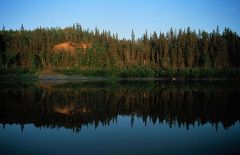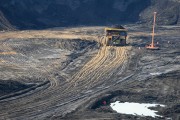The governments of Canada and Alberta recently announced a long-overdue joint implementation plan to monitor the environmental impacts of oilsands development. The announcement met with cautiously optimistic responses as critics welcomed the move to collect better data on oilsands impacts, but highlighted the need for independent governance of the program, and stressed that the new data must be used to drive decision-making about the pace and scale of oilsands development.
Collecting more data alone won’t reduce any of the impacts to land, air, water or the health of people and species in the area, but we found the recent steps to improve oilsands monitoring encouraging. Reflecting back on the many years the Pembina Institute has spent drawing attention to need for better data to inform science-based limits to oilsands expansion, the new monitoring plan is evidence we are making progress.
Building support behind the scenes
As early as 2006, we identified the need to improve environmental monitoring in the oilsands in our in-depth report Troubled Waters, Troubling Trends. The next year, my colleague Dan Woynillowicz participated in the Oil Sands Multi-Stakeholder Committee that identified the need to review and improve (where necessary) monitoring systems. The timeline below provides a chronological look at our work over recent years highlighting the need to improve oilsands environmental monitoring.
Pembina withdrew its participation in the Regional Aquatics Monitoring Program (RAMP) more than a decade ago, when it became clear to us that that industry-dominated program lacked scientific leadership and credibility. University of Alberta scientist David Schindler criticized the program as insufficient and ineffective in 2010, following the release of the Schindler and Kelly study that linked oilsands development with toxins in the Athabasca River.
Despite the shortcomings with the RAMP program, the Pembina Institute continues to support monitoring processes that are better designed. For example, the Pembina Institute is a member of the Alberta Biodiversity Monitoring Institute (ABMI) – one of the primary existing programs that the implementation plan endorsed for expansion and more funding. My colleague Simon Dyer sits on the board of the ABMI as the appointed delegate of the Alberta Environmental Network.
The ABMI is identified as a key component of the Joint Canada-Alberta Monitoring Plan and has many strong elements – scientific leadership, publicly accessible information, and value-neutral result presentation. However, the ABMI still has not secured full funding, so the ABMI’s ability to deliver sound monitoring data is limited by the availability of resources to support its work.
Pembina policy analyst Marc Huot also actively participates in the Wood Buffalo Environmental Association (WBEA), which provides air monitoring for the areas surrounding oilsands development in northeastern Alberta.
Given our work on the environmental impacts of oilsands development and our involvement with monitoring bodies over the years, we consider ourselves to be good judges of monitoring systems that are high quality and credible.
What has been lacking until now is government leadership and adequate resources to ensure a credible, comprehensive and arms-length monitoring system is developed.
And while it took pressure from aboriginal communities and the smoking gun of Schindler and Kelly’s excellent research to show that Alberta’s systems weren’t adequate to detect changes resulting from oilsands development, we are pleased to have contributed to raising concerns about gaps in monitoring and oversight.
Hold the applause
 While we commend the Governments of Alberta and Canada on finally cooperating to lay the groundwork for a credible monitoring program, we think it is fair to hold some applause until we see evidence that our governments are committed to using the information that is gathered to improve how oilsands are managed.
While we commend the Governments of Alberta and Canada on finally cooperating to lay the groundwork for a credible monitoring program, we think it is fair to hold some applause until we see evidence that our governments are committed to using the information that is gathered to improve how oilsands are managed.
There still seems to be a disconnect between acknowledging that we don’t have accurate data to assess impacts, and barreling ahead to approve new oilsands projects.
And it’s clear that monitoring information is not always used to shape management decisions, even when the impacts are black and white. Excellent monitoring by the Alberta Caribou Committee — a group of caribou scientists — has documented a 75 per cent decline in the woodland caribou herds in areas impacted by in situ oilsands development over the past 20 years.
So far, the Government of Alberta and Canada have refused to use this monitoring information to protect caribou habitat — in fact, federal Environment Minister Peter Kent recently stated his intentions not to follow through on his responsibility to issue an emergency protection order for caribou under the Species at Risk Act.
The caribou case shows that sound environmental decisions don’t necessarily follow from adequate information.
Monitoring is the starting point, not the finish line
While monitoring is important, it is only small but critical part of responsible environmental management in oilsands development.
And a lot remains to be done on that front. The Governments of Alberta and Canada told the public for a decade that monitoring was fully under control. And although the need to improve monitoring has now been widely acknowledged, there is still a strong misperception that monitoring alone will improve the damage that oilsands mismanagement has done to Alberta and Canada’s international reputation.
Environmentally responsible oilsands development is achievable, and we at the Pembina Institute are working hard to share solutions to the current gaps in oilsands environmental management with leaders in industry, government and across Canada.
Despite the serious work ahead of us — and the polarization of the debate in which some individuals label those who raise valid concerns about oilsands mismanagement as “adversaries” — it is encouraging to see some initial action on some long standing issues.
Our goal at the Pembina Institute is to provide constructive criticism and solutions that will enable responsible oilsands development, and we are committed to continuing our work to shape the terms of this debate and build support for responsible energy development.









